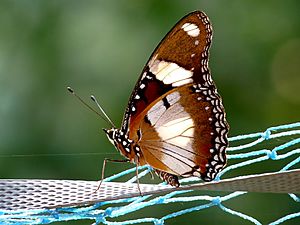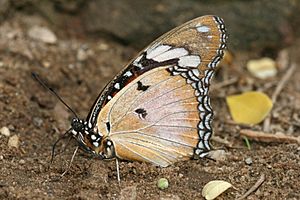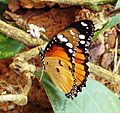Danaid eggfly facts for kids
Quick facts for kids Danaid eggfly |
|
|---|---|
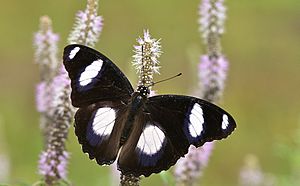 |
|
| male, upperside | |
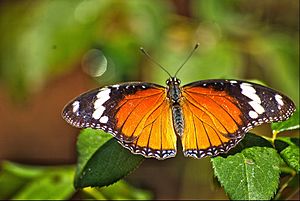 |
|
| female, upperside | |
| Scientific classification | |
| Synonyms | |
|
The Hypolimnas misippus, also known as the Danaid eggfly, mimic, or diadem, is a common type of nymphalid butterfly. It's famous for being able to look very different (this is called polymorphism) and for mimicry, where it copies the look of other animals.
Male Danaid eggflies are mostly black. They have special white spots with blue edges. Female Danaid eggflies can look very different from each other. Some look like the males, while others look a lot like poisonous butterflies such as the Danaus chrysippus and Danaus plexippus. You can find these butterflies in Africa, Asia, and Australia. They also live in the West Indies and sometimes fly into Central and North America.
What Does It Look Like?
The male Danaid eggfly has dark, velvety brownish-black upper wings. On its front wing, there's a large white oval spot. There's also a smaller white spot near the tip of the wing. These white spots have black lines running through them. They also have a shiny blue border that you can only see from certain angles.
The hindwing (back wing) has a bigger white spot. The lines crossing this spot are yellowish. The edge of the wing has small white and black marks.
When you look at the underside of the male's wings, the colors are different. The front wing has light brown and golden brown areas. It also has white spots and lines. The hindwing has reddish-brown areas with a wide white band across the middle.
Female Butterflies Female Danaid eggflies are very interesting because they can have many different looks. This is called being polymorphic.
- First look: Many females are a rich reddish-brown color on their upper side. The front wing has black areas, especially near the tip and along the edge. It also has white spots and thin white lines.
- Second look: Some females look similar to the first type, but the middle part of their hindwing is white.
- Third look: Another type of female looks like the first form, but the white spots on the front wing are yellowish instead. Also, some of the black areas near the tip of the wing are reddish-brown.
Life Cycle
The Danaid eggfly goes through a complete life cycle, just like other butterflies.
Larva (Caterpillar): The caterpillar is black and shaped like a cylinder. It has a darker black line down its back. It also has pale brown spots that are bumpy. The underside is dark olive-brown. Its legs and head are brick-red. The head has two long, thick, branched black spines. The rest of its body segments have ten branched spines that are a dirty, clear white color.
Food Plants: The caterpillars eat plants like Portulaca oleracea and Asystasia lawiana.
Pupa (Chrysalis): The pupa hangs upside down. It is short and thick, light brown in color. It has streaks and patterns of darker brown, especially near its head and tail.
Clever Mimicry
The Danaid eggfly is a Batesian mimic. This means it copies the look of another animal that is dangerous or tastes bad to predators. In this case, the Danaid eggfly looks like the Danaus chrysippus butterfly.
The Danaus chrysippus butterfly is poisonous to birds and other predators. Because the Danaid eggfly looks so much like it, predators often avoid eating the Danaid eggfly too. This helps the Danaid eggfly stay safe from being eaten!
Images for kids


